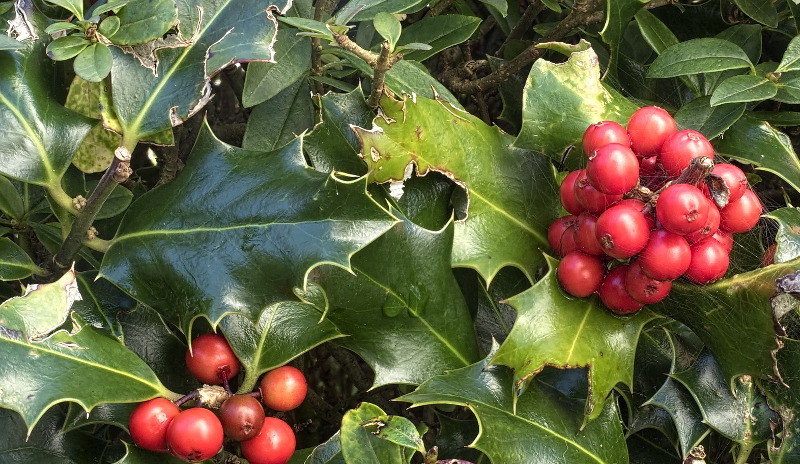The berries of all hollies (Ilex species) are poisonous to humans and pets as well as some farm animals. Most hollies are dioecious with separate male and female plants. Only the female plants produce berries, which contain the toxic compound saponin. Ingesting the berries can lead to diarrhea, vomiting, dehydration, and drowsiness. Several reports describe holly leaves as safe, but they are usually left alone because of the leathery texture and spines.

Are Hollies Poisonous to Children?
Many people gather holly branches for indoor decorations during the holidays. Children may try to eat the berries thinking they resemble candy. It is important to impress upon children that they cannot eat the berries. The berries are poisonous and may cause vomiting and diarrhea, although no cases of death have been reported.
Keep young children away from holly plantings and consider adding a barrier to prevent children from accessing the berries. For peace of mind, you can plant a male or sterile plant, which does not produce berries.
Are Hollies Poisonous to Cats & Dogs?
Although holly leaves are typically ignored, pets may ingest the berries and experience adverse symptoms such as vomiting or diarrhea. Consumption of a few berries is probably not harmful, but eating larger quantities merits a trip to the vet for immediate treatment.
The red berries can wither, dry and fall off an arrangement or a shrub. The best solution is to harvest branches without berries and use cranberries in the arrangement for color so you don’t have to worry about the berries being eaten. If pets have access to areas with holly plantings, you may need to put up a barrier to keep the animal away.
Are Hollies Poisonous to Other Animals?
Yes, hollies are considered mildly toxic to most livestock and should not be planted near grazing areas. Hollies are generally deer resistant and ignored by deer, but blue hollies are considered to be delectable.
Hollies are a good choice to attract birds and are not poisonous to them. Several species enjoy eating the berries when other food sources are scarce, including robins, cedar waxwings, mockingbirds, blue jays, mourning doves, grouse, bobwhite, wild turkey, blackbirds, redwings, thrushes, and cardinals. Birds also use the dense branches for cover.
Symptoms of Holly Poisoning
The berries are the poisonous part of the plant. Eating holly berries can cause gastrointestinal distress. The branches and foliage don't seem to be troublesome, although evidence for this is lacking.
Here are some common symptoms to look out for:
- Vomiting
- Diarrhea
- Dehydration
- Stomach cramps
- Drowsiness
- Skin irritation, including rash (less common)
Pet Poison Helpline
If something were to happen to your furry friend, and you suspect that they are suffering from holly poisoning, there is a poison control hotline to call for 24/7 vet advice. It is called the Pet Poison Hotline, and their phone number is (855) 764-7661.
Click here for a complete list of Pet Safe Plants.
Sources:
"Holly Berries: A Beautiful Decoration but a Poisonous Snack." poison.org
"Holly." American Society for the Prevention of Cruelty to Animals. aspca.org
 |
Author Chris Link - Published 10-19-2021 |
